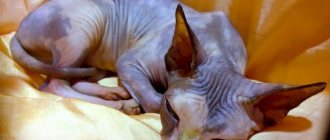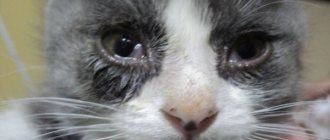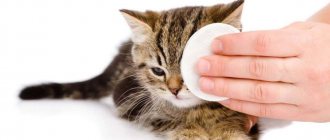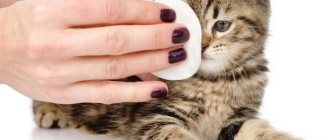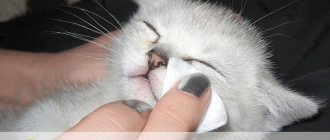Inflammation of the tear duct in cats is a fairly common phenomenon that can be caused by a number of different pathologies. Some of them are dangerous and can cause serious deterioration in visual function or even cause complete loss of vision. That is why, when there is inflammation of the visual organs, it is important not to self-treat and visit a veterinarian.
Causes and symptoms
Keratitis and inflammation
The pathology is characterized by inflammatory processes of the cornea, during which it becomes cloudy. The disease can be triggered by injuries, conjunctivitis, burns, allergies, as well as autoimmune and infectious diseases. The pathology can affect either one or two eyes at once. Swelling of the mucous membrane of the eye often occurs, tear tracks are observed, and sometimes there are impurities of pus in the discharge.
Development of iritis
It is an inflammation of the iris of the eyeball. The pathology is caused by bacterial and viral diseases, fungi, and traumatic eye injuries. The following symptoms are characteristic of iritis:
- photophobia;
- constriction of the pupil;
- pet's irritation.
Panophthalmitis
This dangerous disease is often provoked by Pseudomonas aeruginosa.
Total purulent inflammation and melting of all structures and membranes of the eyeball is caused by infection with pneumococcus, staphylococcus, and Pseudomonas aeruginosa. Pets experience severe pain, which causes them to scream and roll on the floor. The cat becomes restless, aggressive, and reacts painfully to light. The lacrimal gland is inflamed, the eyelids are swollen and hot. The formation of pus is observed in the anterior chamber of the visual organ, and a rupture of the sclera can often be seen.
Dacryocystitis
This is an inflammatory process in the lacrimal sac, which is mainly diagnosed in a chronic form. In addition to the fact that inflammation and obstruction of the nasolacrimal duct is observed, there are the following symptoms:
- swelling of the conjunctiva;
- redness of the mucous membrane;
- discharge of different consistency and shade.
Blepharitis in cats
A characteristic feature of the disease is the appearance of swelling of the eyelids.
The disease is characterized by inflammation of the edges of the eyelids. Animals experience severe itching of the visual organs, as a result of which they can scratch their eyes and cause injury to both the eyelid and the cornea. In cats, a tear track is noticeable, and the discharge may be purulent in nature. There are also the following symptoms:
- swelling of the eyelids;
- corneal clouding;
- change in iris shade;
- aggressiveness;
- fear of light.
Third eyelid
The visual anatomy of cats is different from that of humans. They have a nictitating membrane that protects against a variety of injuries. The film is a thin layer of light skin that is located near the inner corner of the organ of vision. If there is prolapse of the nictitating membrane, there is an increased secretion of tears, and sometimes pus may be noticeable. This pathology is caused by conjunctivitis, disruption of the gastrointestinal tract, bacterial damage, and allergic reactions.
Cataract
With this pathology, the lens visually becomes cloudy.
During the development of this disease, clouding of the lens occurs. Older cats are more susceptible to the pathology, however, the disease can also be diagnosed in kittens due to infection. The main symptom is deterioration in visual function. The pet begins to have difficulty navigating in a room that is familiar to it, and bumps into people and objects.
Entropion and injuries
Turning inward or outward occurs. The pathological condition is caused by burns, inflammatory processes, as well as traumatic injuries. In addition to inflammation of the tear duct, the cat suffers from pain, which occurs due to constant rubbing of internal tissues by hairs. As for eye injuries, they can be both superficial and deep. Cats that roam outside often get into fights with other animals and get seriously injured. In this case, there is an increased secretion of tears, redness of the mucous membrane of the organs of vision and inflammatory processes.
Epiphora and lacrimation
This symptom can accompany many eye pathologies in an animal.
As the disease progresses, cats suffer from constant and uncontrollable production of tears.
Tracks are visible on the cheeks, the coat becomes brown. This condition can be provoked by the presence of foreign objects in the eye, a corneal ulcer, or conjunctivitis. In addition, epiphora in cats can also be caused by improper development of the lacrimal lines. Often there is a tight fit of the lower eyelid to the eye, and a small size of the lacrimal lake.
Glaucoma in cats
A disease accompanied by increased intraocular pressure and an enlarged eyeball.
Symptoms of glaucoma in cats
Symptoms are visible to the naked eye. There is an enlargement of the pupil, reflection of the fundus, bulging of the cornea, which is no longer mirror-like. If this disease is not cured in time, the animal may permanently lose its vision as the retina dies.
Treatment of glaucoma in cats
It is carried out only with drugs that reduce intraocular pressure. To restore the cornea and prevent it from drying out, an ointment is prescribed. To prevent such a disease in your pet, you need to carefully remove discharge from the eyes with a swab, after moistening it in a special lotion for animals. Lotions are available both for external use and for treating the cornea itself, so you need to carefully read the instructions for use.
How is the treatment carried out?
According to leading veterinary ophthalmologist Alexey Germanovich Shilkin, it is preferable to use medications to treat pathology, and resort to surgery only in rare cases.
Depending on the cause of the disease, antibiotic drops are selected for the animal.
If an animal has a blockage and inflammation of the tear duct, treatment for this condition is prescribed depending on what caused the problem. Pets are prescribed eye drops that have an antibacterial effect. If a fungal infection is observed, fungicidal medications are prescribed. When inflammation of the lacrimal duct is accompanied by photophobia, it is important to move the animal to a room with dim light.
Sometimes treatment involves washing the organs of vision with disinfectant solutions. It is important not to forget that the use of any medications should be carried out with sterile objects and well-washed hands. Drops are instilled using a clean pipette into the conjunctival sac. Medicines for external use are applied with a spatula to the inner corner of the visual organs and carefully applied along the outer eyelash line. After this, the eyelids are connected and a light massage is performed.
Hidden infections
Hidden infections, and most often chlamydial infections, cause profuse lacrimation in animals. In most cases, latent infections occur without changing the general condition of the body. The animal behaves actively, has a good appetite, and the only symptoms observed are profuse lacrimation, while the tears are completely transparent. To identify hidden infections, the polymerase chain reaction (PCR) method is used, which allows you to identify the specific causative agent of the infection (DNA of bacteria, viruses, protozoa). If a specific pathogen is identified, a course of specific antibiotic therapy is applied.
If you observe prolonged lacrimation in your pet, this symptom is a reason to contact your veterinarian.
Unfortunately, ophthalmological diseases in felines are not so rare, and these ailments are not always easily cured.
Cataracts in cats
Cataracts are a disease that occurs in older cats (very rarely in young ones) and is characterized by clouding of the lens.
Also, a cat can get this disease during a fight or if the cat suffers from diabetes. Treatment is carried out with the help of surgery, removal of the lens. You can also use drops at the initial stage of the disease, but they only slow down the process slightly and do not eliminate the cloudiness.
Blepharitis in cats
Inflammation of the eyelids, which causes thickening and redness of the edges of the eyelids.
There are several types of blepharitis: simple, meibomian and ulcerative .
Let's look at each type in more detail. Simple blepharitis. With this disease, there is overflow of blood vessels (hyperemia) and thickening of the edges of the eyelids. Gray-white scales appear at the base of the eyelashes.
If the edges of the eyelids swell and their surface becomes covered with pus and an ulcerative surface appears under it, this is no longer simple, but ulcerative blepharitis . The main symptom is watery eyes and itching of the eyelids. If inflammation affects the roots of the eyelashes, they fall out. Entropion or inversion of the eyelids may occur. Ulcerative blepharitis is treated by removing dead tissue, after softening the surface of the eyelids, this is best done with fish oil. Then the edges are cauterized with a special disinfectant and washed with water or saline solution. Then, within a week, an ointment containing antibiotics is applied to the affected areas of the eyelids.
And another type of blepharitis is meibomian. Appears due to hypersecretion of the meibomian glands (named after the physician Heinrich Meibon). Signs include hyperemia and severe thickening of the edges of the eyelids. Pathogenic microorganisms that enter these glands cause purulent inflammation of the eyelids. To treat this inflammation, “green stuff” and yellow mercury ointment are used.
Before you begin treatment, you need to take your beloved animal to a veterinarian who can choose the right treatment for your pet. It is not recommended to use medications without the consent of a specialist, as improper treatment can aggravate the situation.
Keratitis in cats
Keratitis is an inflammation of the cornea of the eye, causing it to become cloudy.
There are several types: superficial, deep, purulent and non-purulent. Superficial keratitis affects the outer epithelial layer, while deep keratitis affects the corneal parenchyma.
Signs of keratitis: clouding of the eye, redness, lacrimation, squinting of the eye, suppuration, photophobia.
The causative agents of keratitis are herpes simplex viruses, which are transmitted through dirty objects. Bacterial keratitis also occurs. Its causative agents are Pseudomonas aeruginosa, coccus, gram-negative and gram-positive bacteria.
Treatment of keratitis in cats
Treatment should begin after determining the cause of the disease. Bacterial keratitis is treated with medications containing antibiotics.
If treatment is started on time and effectively, the disease goes away and the transparency of the cornea can be restored. Otherwise, multiple complications may begin.
Dacryocystitis in cats
Dacryocystitis (inflammation of the lacrimal sac) - in most cases occurs due to the transition of the inflammatory process from the conjunctiva, lacrimal duct or nose.
How to recognize this disease. The mucous membrane of the lacrimal sac becomes swollen, the discharge becomes abundant and, in most cases, purulent. Discharge is observed from both the eyes and nose. There may be a lack of coordination and this disease can lead to loss of vision.
Treatment is mainly carried out with medication. In very rare cases, surgery.
